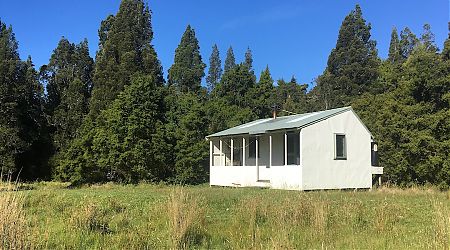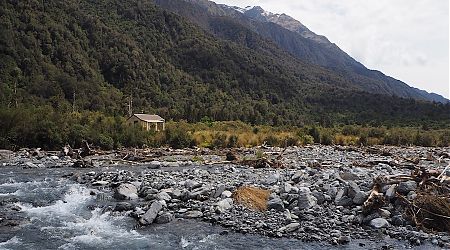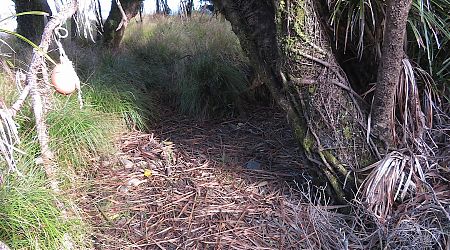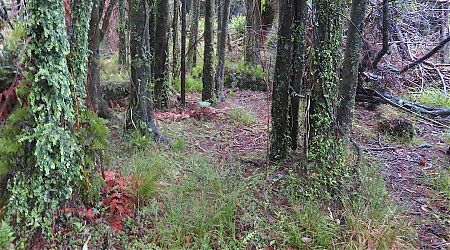West Coast huts and bivvies
No. This website doesn’t document many of the 140 backcountry huts found on the West Coast between Karamea and Haast.
Well, there aren’t many easy, or even hard loop tracks on The Coast.
The rivers are steep, and a real boulder festival. Often the route is just following the riverbed where rock hopping over car, bus, house sized boulders, and getting your feet/undies wet are required, even when the weather is good. The mountains are also very steep. It ain’t so easy popping from one river valley into the one adjacent.
With a few relatively easy exceptions, Welcome Flat, Cedar Flat, expeditions into the West Coast hills are, err, expeditions.
You need considerable experience in trail finding as the tracks can be poorly marked, you may be required to cross hair raising slips, or wait out flooding in rivers, etc. It is not simply a step up from the Great Walks, it can be demanding, energy expending tramping at its purest.
Due to the high rainfall, 10 m a year is common, and the steepness of the terrain, the rivers get up super quickly. That also means they can drop almost as fast. A 300 mm deluge in 24 hours happens often enough.
The remotehuts.co.nz, remotehuts.co.nz/huts/, website documents 66, err, remote huts or bivvies on the western side of the Southern Alps. Many are the most difficult/strenuous/foolhardy huts to access. Some are therefore seldom visited. The 66 huts/bivvies are no longer fully maintained by DOC and are now cared for by the hard working volunteers of the Permolat Trust, remotehuts.co.nz/about. Thanks for not allowing DOC to demolish these refuges, as was proposed by DOC back in 2002.
Here’s a few huts and bivvies from The Coast . . .


It’s a great day walk out from Karamea through regenerating forest on a fully benched track.
Main attraction: it’s cheap, and can be used as a base for a day walk up to the hot pools if the Welcome Flat Hut is fully booked.
This private hut is perched above the Hope River at the end of the route from the Jackson River roadend.
One big room with the sleeping platforms, so it’s totally social. No escape there.
It seems cruel to refer to this delightful historic hut as Blowfly Hut, considering it’s been more than 50 years since cattle ceased traversing the Haast Paringa Cattle Trail. Blowflies are not such a common occurrence these days.
One of the great DOC hut locations, with the hut matching in quality.
Buckland Peaks is a splendid hut with a ply-lined interior, double-glazing, insulation, etc. With a view down to the Buller River and the lights of Westport way down there.
Callery Creek is possibly the best campsite between Barn Bay and Gorge River.
Fortunately Cedar Flat Historic Hut, an old Forest Service hut has been retained, and done up to be acceptable accommodation.
Cedar Flat Hut is a fairly popular West Coast hut due to its proximity to the road end, it’s a half day walk, and being only a short walk to some acceptable natural hot pools.
Ces Clarke Hut was built back in 1986 when the Croesus Track was cleared for recreational use, after having been abandoned for many years.
Memorable due to the hordes of mosquitoes that seem to find some way into the hut. Expert tip: bring your own mozzie coils, or even a can of fly spray.
Crystal Biv is a mattress-less shelter that was essentially rebuilt in 2019.
Dickie Spur Hut is still essentially an unheated shed, being above the tree line.
Douglas Rock Hut is in a spectacular setting with a backdrop of some of the tallest mountains in New Zealand.
A modern DOC hut, ie, insulated, double-glazed, sandfly screens, on a river terrace above the Whitcombe River.
Two is full capacity. Three or more would need to be, or become, very good friends.
Of historical interest rather than actual accommodation, this restored hut gives an idea of the basic living conditions the miners endured.
Gorge River is potentially massive in flood and high tide but can be forded at low tide. Robert Long leaves a canoe and rubber ducky together with paddles/oars on each side to allow crossing at other times.
Grassy Flat Hut is the biggest, newest, and most comfortable hut in the area. Double glazed, well insulated, etc.
Note that a stay here will test the limits of your insect repellent.
Harman Hut is another standard NZFS SF 70 six bunk hut from the 1960s deer culling days.
An easy-ish three hour walk up from the Haast Paringa Track. But not much visited due to the cul-de-sac nature of the valley.
Just an easy hour’s walk from the unsignposted turn-off makes it suitable for youngsters to have a first taste of West Coast forest and an overnighter away from home.
A great introduction to overnight tramping.
Lower Arahura Hut is set on a river terrace perched above the Arahura River.
The Maori Saddle and Coppermine Creek huts suggest the New Zealand Forest Service once had some ambition for the Haast Paringa Cattle Trail. But the 10% difficult sections, and the nine-hour listed time between huts have not popularised the track as planned.
If you make it up to Horseshoe Flat you may as well continue up to Middle Head Hut. Built just prior to the nearby Horseshoe Flat Hut, and receives even fewer visitors.
Mikonui Flat Hut is a standard six-bunk SF 70 ex-New Zealand Forest Service hut in reasonable condition that is used by hunters who can cope with the hour’s walk to the hut.
Sadly, as is common with huts accessible by vehicles, it can be left in an untidy state.
Five-star accommodation with double-glazing, heavy insulation, big picture windows, LED lighting, two bedrooms.
If you are fit and frisky, the track up to Mount Brown Hut is a great test of your fitness, and general capabilities.
Good views both up and down the valley, and decent afternoon sun, well, if it’s sunny.
Note that this is a little bigger than a four-person tent, and while you can sit up on the bench, the door is two-thirds height and standing up inside is not possible.
Yeah, she’s fairly hard to get to these days. And it’s in one of the wettest areas of New Zealand.
Pororari Hut sits at the intersection between the dramatic limestone escarpment, and the lovely forest, sometimes almost pure tree-fern, and the Pororari Gorge with more limestone cliffs, and plenty of nikau palms.
Comfortable ex-New Zealand Forest service S81 four bunker on a grassy flat with an impressive mountainous backdrop.
Good campsites either side of the creek. The south side, in the forest, is more sheltered due to the tree cover.
Someone has removed a few flax bushes on the south side of the river to create a flat and somewhat sheltered place for two tents.
A splendid hut adjacent, almost, to the superb coastline only four hours from the road. Sounds great. And it really is a Top 5 rated hut.
It was designed for hobbits, with a two-thirds-height door, and it is not possible to stand up inside.
Plenty of graffiti from those who have stayed over the years adorn the walls.
Top Toaroha Hut is another old New Zealand Forest Service six bunker, there were 100s of these built.
It needs to be booked, and it’s locked. Mostly used by school groups, etc, and has facilities to suit.
Eight almost level campsites have been created in the tussock to allow tents to be pitched.
Welcome Flat Hut has become so popular because of the adjacent and entirely excellent natural hot pools that a year-round booking is operational. Note that if you do not have a booking this can cause major problems if you just turn up.
The rock bivvy is for those who appreciate living in the outdoors.
Yates Ridge Hut is not quite on the ridge, but does have a great view of Zit Creek, Adventure Bivvy standing out clearly next to a major waterfall on the other side of the creek, and the steep climb to Zit Saddle if the clouds are high.















































